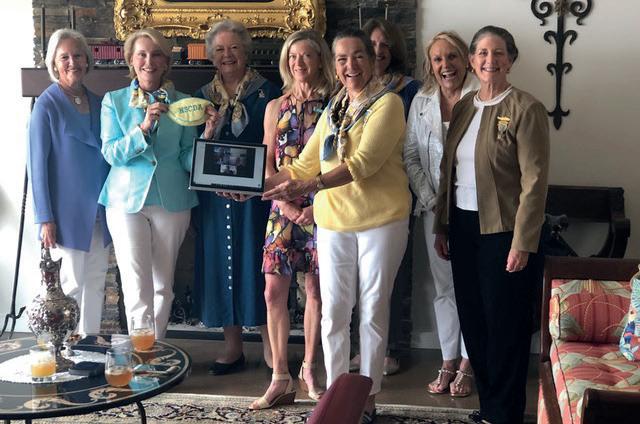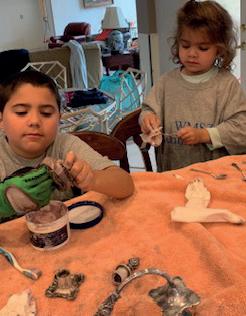
7 minute read
Dumbarton House / Transcending Crises
by KELLY PARAS, NSCDA Digital Communications Specialist
Throughout history, nearly every generation of Americans has faced years of war, devastating economic turns and public health emergencies. We are living in a unique time – a global pandemic on a scale difficult to fathom. We are acutely aware that this historic time will provide a reference point for generations to come. In our awareness of our historical present, we look to the past for inspiration.
Dumbarton House, our NSCDA National Headquarters and Museum, was built in 1799 just 23 years after the founding of our nation, and it has stood witness to every national crisis and triumph since. The Dumbarton House archives reveal that even before the NSCDA took ownership of the property, it had a history of being a safe space and a place of service. During the War of 1812, our nation’s new capital city was threatened by an invading British Army. First Lady Dolley Madison waited until the last possible moment to leave the White House as she gathered precious documents and objects, including a copy of the Declaration of Independence and Charles Wilson Peale’s iconic portrait of George Washington. Dolley Madison became our nation’s first and most heroic preservationist, and when she finally left the White House grounds, she fled to the safety of Dumbarton House. With the city and White House ablaze, the brick structure of our National Headquarters shielded some of America’s most beloved national treasures from destruction. Just before America was gripped by the Great Depression in the 1930s, the Dames rallied and looked inward to strengthen their mission. Former NSCDA National President Clarinda Pendleton Lamar led a search for a National Headquarters for the organization. She found Dumbarton House, then called Bellevue, on the heights of Georgetown; while the property was not for sale, she was determined to acquire it. She wrote to the owner and so compellingly explained the reason that the NSCDA wished to buy it that the owner agreed to sell. The Dames purchased the property independent of their husbands (a rare feat for the time). The property could not be purchased without the NSCDA being incorporated, which required a formal act of Congress (which they obtained). The home was valued at $225,000, yet Mrs. Lamar convinced the owner to sell it for just $185,000, and the Dames raised all of themoneytopayoffthatmortgagewithintwoyears–during the Great Depression. The Dames doubled down on their dedication to historic preservation, fully restoring the house and opening it as a museum in 1932 with First Lady Lou Henry Hoover in attendance.
The outbreak of WWII altered our nation forever. In January 1942, the NSCDA offered the ground floor of Dumbarton House to the American Red Cross as a service unit for the organization. Then NSCDA National President Mrs. Low remarked, “Although old houses are valuable, they are not as valuable as the boys in the Service whom we wish to help, many of them our own sons.” This collaboration with the Red Cross has served as a model going forward, as Dumbarton House has been the site of blood drives and
support events for the organization in the years since. As COVID-19 spread across America and the world, Dumbarton House did not hesitate to respond. With centuries of history and a heavy sense of duty behind it, the site quickly coordinated with other historic properties and museums to gather Personal Protective Equipment urgently needed by local healthcare professionals.
As Washington, D.C. came to a standstill, Dumbarton House was determined to remain an asset to the community and opened its grounds as a safe refuge for neighbors and residents seeking outdoor space. Dumbarton House transitioned to distance education and online learning, providing resources for families across the country who unexpectedly began homeschooling their children.
The common thread across this entire history of crises is a measured, thoughtful approach to providing aid and assistance while staying true to the mission of the organization. How fitting that even before the NSCDA was involved with Dumbarton House, a legacy of community aid was already in place to serve as inspiration.


Colorado Society is bringing history to life in their Great American Treasure, the Hotel de Paris Museum. In 2021, they will open the Brasserie de Paris in an effort to bring the museum closer to its history and create a new revenue facet. Virginia Society is pleased to announce the Celebration Shawl and Pocahontas Pin, available for purchase. For information on the history behind these designs or to order, please visit nscdava.org/shop Indiana Society has restored the historically accurate garden at the David Lenz House in New Harmony. A walk through the garden offers the community solace during these challenging times.

Bows are a great way to make new members feel welcome. Please contact Margo Barry to receive new member bows. Three town and county commmittees of the CA Society welcomed (with bows!) three new members this summer. Pictured left to right: Candidate CiCi Williamson, Past TC Chair Anne Rhett Merrill, Historian Mary Collier, New Member Barbara Hill, President Sarah Heatwole, Past TC Chair Robin Martin, TC Vice Chair Julie Willig and Candidate's Helper Susie Mitchell. On the Zoom Call were New Members Chana Jackson and Deanne Violich and TC Communications Chair Judy Mack.
West Virginia Society is making the most of the lockdown by cleaning the Craik Patton House gardens so visitors can enjoy the garden and smell the flowers — a welcome distraction from being cooped up at home for many months!

Kansas Society member Virginia Garver, the oldest (100 years old!) and longest member of the Wichita Town Committee, has made dozens of masks for the residents of her assisted living facility in Wichita. This avid seamstress is a Kansas native and attended Sweet Briar College in Virginia, graduated from Boston Children’s Hospital school of nursing and was a nurse for many years.




National Historian/
Archivist Lea Uhre taught her grandchildren, William (7) and Sophie (4), about their family history by cleaning silver together and becoming history detectives in the process! Arizona Society’ s first Young Dame, 13-year-old Madison Schantz, her mother, Lissa, and Raimie Manch, AZ Society Registar, created and taught a lesson to 3rd-grade students on the art of the thank-you note. Raimie shared notes from her family that dated back to 1887.
South Carolina Society member Allie P. Walker (pictured, on right, with Helen D. Holland, on left) helped start Help 4 Kids, a ministry in Florence, SC that provides food on weekends for elementary school children who would have nothing or very little to eat. During COVID-19, Allie worked with donors and volunteers to sort food, pack bags and deliver them to drop-off sites where students or family members could pick them up. Allie continues the long tradition of Dames rising to the occasion to overcome obstacles and challenges. Washington Society purchased a 1777 letter from George Washington to General Nelson during Washington’s service as General of the Continental Army. The letter is on display at the state’s capitol in Olympia. The WA Society created a grant-award program to support historic preservation and is continuing their commitment to History Day. Wisconsin Society’s Agency House hosted a community archaeological dig to locate an 1830s blacksmith shop which was established at the Agency to serve the Ho-Chunk Nation.

Iowa Society has partnered with the State Historical Society to sponsor History Alive workshops, which included a field trip to the Iowa State Capitol where students heard about Iowa’s important role in political history. Students also learned about Iowa’s unique caucus process, the importance of Iowa’s constitution, and the role that Iowa’s supreme court decisions played in shaping the laws of the state.












